Zebra finches are sometimes given the tags English, German and American. This is a broad categorisation relating to their size. ‘American’ birds are similar in dimensions to wild Zebra finches, while ‘English’ and ‘German’ ones are larger, bred for shows that have included the notion of bulk in their definitions of the ideal bird. This bulkier type of finch is sometimes described as ‘cobby’ by breeders. In general, German birds are a bit larger than English ones; but none of these tags are very useful, and the boundaries between them have become blurred.
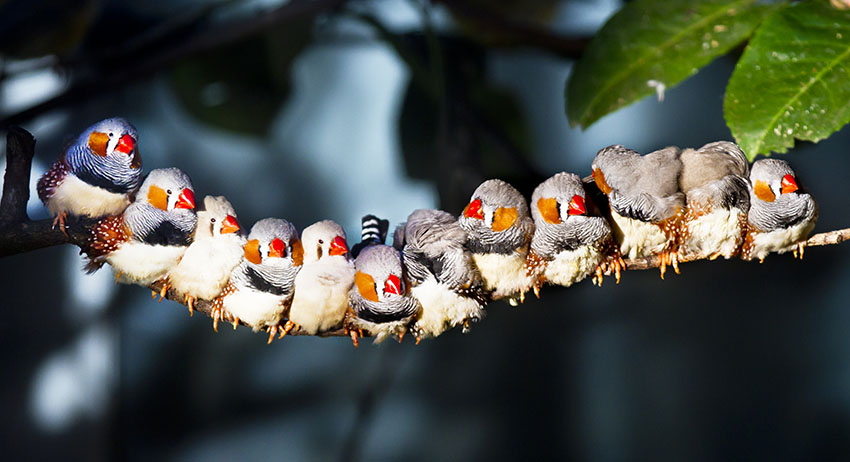
Zebra Finches - English, German or American?
Selective breeding has produced many colour varieties of Zebra finch. Basically, the birds can have one of two background colorations - Standard (Grey), or Fawn.
Zebra Finch Colour Types
Each of the following is recognised as a distinct variety by bird shows. These colours are set against a background of one of the three varieties mentioned above - Grey, Fawn or White.
Standard Type, or Grey
This is the classic Zebra finch, with the same grey, black and chestnut basic coloration as the wild bird.
Black-Breasted
These birds differ from standard Greys in most plumage details. The large black breast marking is is the feature that gives the bird its name. Their cheek patches are very big; they lack the Zebra finch’s distinctive facial ‘tear’ stripe; and their flank spots are larger and more stretched, often producing a streaked or spotted effect. The tail tends to be coloured and patterned differently too, and there may be orange or white flecks on the wings. The Black-breasted is frequently crossed with other types of Zebra finch, giving rich variety. If the bird you are looking at has a wide black splodge on its chest, it’s a Black-breasted Zebra of some sort.
Black-Cheek
These birds have black cheeks, as you would guess from the name, masking the ‘tear’ stripe that sits alongside it. They also have black on the flanks where a standard Grey type would have chestnut. The Black-cheek is frequently crossed with other types to combine key plumage features. Like the Orange-breasted, this mutation was first spotted and isolated in the late 1970s. The distinctive black cheek of the bird is not a robust genetic feature, and breeders often struggle to get the markings dark and distinct.
The Black-cheek, combined with Fawn birds, produces a hybrid Fawn-cheek coloration, with the black replaced by brown.
Black-Face
These finches have more black on the face than standard Grey types, and their breasts have extensive black too. This varies, but sometimes stretches across the whole underside from chin to vent. The effect is far subtler in hens, some of which are hard to distinguish from Greys. The birds are often crossed with Black-cheek and Black-breasted types to produce extensive areas of dark plumage. When crossed with the Orange-breasted variety, the blacks and oranges vie for prominence.
Australian breeders have taken this to the limit with a very black bird referred to as Black-bodied; although this is not yet recognised as a variety seperate from the Black-face.
Black Front
This variety is restricted to Australia, where it was developed in the mid-1960s. The birds look like standard Greys, but with an extensive black area running from the throat to the flanks. Unlike the Black-breasted variety, they have thick black tear-stripes on the face.
Chestnut-Flanked White (CFW)
These are white-bodied birds with brown flanks (although this is often absent), and with the standard markings of the head and breast intact. These markings are very faint on some varieties of CFW. Their tails are light brown or grey, depending on whether the bird is from Grey or Fawn genetic stock, and the head colours tend to be less striking than standard birds. Some are predominantly white, and there is a certain amount of potluck involved in breeding this variety.
There are two distinct types of CFW - the Regular, ‘old’ CFW (aka Black-eyed or UK CFW) and the Continental, ‘new’ CFW (aka red-eyed CFW). The Continental has darker bars on its tail, a creamy tinge to the back, and distinctive dark red eyes.
By mixing and matching different Zebra finch types, breeders have come up with other complex variations on the CFW theme, including Black-breasted, Orange-breasted, Black-cheek, Fawn and Lightback CFWs.
Crested
The gene responsible for the crest is commonly combined with other varieties to produce Crested Fawn, Crested Black-face, etc. In the ‘ideal’ crested Zebra finch the crest is a circular arrangement of feathers on the bird’s crown, but sometimes it’s reduced to a few upturned feathers, a half circle instead of a full one, or just a general untidiness that looks less ‘show winner’ and more ‘bed-head’.
Eumo and Charcoal
These two types are very dark birds with a silky appearance to the wings. This is a result of the feather barbs not interlocking - it may look pretty, but it hinders the bird’s ability to fly. Eumos were developed in Europe, while the Charcoal mutation arose in Australia.
Fawn
These birds have less melanin (dark pigment) than Standard types, turning the grey and black coloration to fawn (light brown) and dark brown. The colours on the cocks’ cheeks and flanks are slightly lighter. Males sometimes have off-white, buff-tinged bellies instead of the standard white; females nearly always sport the buff colour. Fawn fledglings have lighter skin than standard chicks, another sign of the reduced melanin.
The fawn gene has been combined with other mutations to produce a complex mixture of patterns such as Black-headed, Black-breasted, Silver, and Orange-breasted Fawn. Birds that have been under a lot of direct sunlight can suffer faded or bleached feathers, giving a blotchy, ‘pied’ appearance. This is harmless, and the colours will return when the bird moults. It therefore follows that a bird sporting this type of plumage is not a distinct variety.
Fawn Zebra finches often have fluffier feathers than standard birds, a feature known as buff. The markings on these birds tend to be less distinct, making them unpopular with breeders intent on shows and exhibitions.
Fawn Cheek and Grey Cheek
In these birds, the grey or fawn feathers (depending on the base colour of the bird involved) are faded to white or off-white. The birds’ cheek patches show the base body colour (grey or fawn). The markings on the breast are faded too.
Grizzle
These Zebras have white flecks across their plumage, creating a so-called ‘salt and pepper’ effect. Some have white crowns too, a variation usually referred to as White-capped Grizzle. This variety first appeared in Australia in 1959.
Isabel and Florida Fancy
The black pigment eumelanin is absent in these varieties. This makes the orange and brown markings of the head and flanks stand out against a background of white. Some have a silvery sheen, and a creamy brown belly.
The difference between the Florida and the Isabel is down to genetics - the absence of pigment is dictated by a dominant gene in the American-bred Floridas, and by a recessive one in the European- and Australian-bred Isabels (i.e. it will not manifest unless matched with another recessive gene).
Both varieties were unveiled at exhibitions in the 20th century, with the Floridas first appearing in the early 70s. The name Florida Fancy reflects the bird’s first emergence, at Tarpon Springs in Florida. The name “Isabel” has, on the surface, an equally simple explanation, as ‘Isabella’ or ‘Isabelline’ is the name for an orangey-brown colour. But the tag is an unsavoury historical joke, a reference to Queen Isabel, who wore the same underwear for months on end, after vowing not to get changed until a certain siege had been won. When this was finally achieved, the garments had turned ‘Isabelline’!
The Queen in question is popularly thought to have been Clara Eugenia (1566-1633), Queen of the Spanish Netherlands and daughter of King Philip II of Spain. The vow related to the three-year long Siege of Ostend. However, the ‘Isabelline’ word had been coined before this time, and is more likely to have related to Queen Isabella of Castile (1451-1504) and the mere eight-month long Siege of Granada.
Lightback
Superficially this variety looks like the standard Grey type. However, their heads, wings and backs are silvery grey, much lighter than Greys. They also have bright white bellies and tail coverts, and lighter cheek patches and flanks (diluted to an an apricot colour). They have been combined with other varieties to produce complex variations such as Lightback Black-cheek, Black-breasted and Orange-breasted birds.
Orange-Breasted
Birds carrying this gene have orange instead of black markings on the breast, throat, tail and ‘tear’ stripe. This stripe doesn’t stand out like a black stripe does, as it sits beside, and merges into, the orange cheek patch. The birds are frequently crossed with other types to produce Orange-breasted Lightbacks, and the seemingly contradictory Orange-breasted Black-breasted, in which the black sits at the heart of the extensive orange chest markings. Orange-breasted Black-breasted Fawn types are the most orange of the varieties, the colour merging very effectively with the light and chestnut browns of the underlying Fawn coloration.
Orange-breasted Zebra finches are a recent mutation, first cropping up in Belgium in the late 1970s. Some breeders make it their life’s ambition to produce birds with all orange and no black markings on the breast, a fiendishly tricky task.
Penguin
The Penguin Zebra definitely wins the prize for the best variety name. Penguinism is a mutation that suppresses the melanin pigment, removing the grey and black features on the finch. The orange cheek patches and flanks are still present, but the breast bar and tear marks are absent. What remains is a frosting of orange and brown, depending on what other type the bird has been crossed with. The Penguin effect is most commonly combined with the Black-cheek.
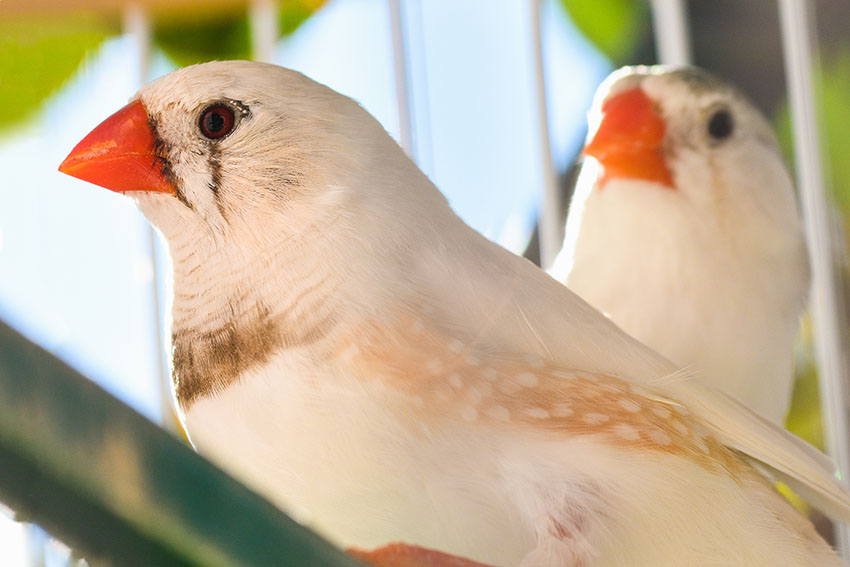
American Chestnut Flanked White finches
Pied
These birds have random patches of white, blotting out the usual markings. The extent of this bleaching varies from bird to bird. Many breeders dislike the effect and avoid breeding any bird that shows a single out-of-place white feather. By breeding a pied finch with another, the bleaching and blotting effect is enhanced through the generations, until little of the underlying colour shows. The last markings to disappear are on the back, and birds sporting this last splash of colour are called Saddlebacks. The endgame of this breeding path is a totally white-feathered bird.
Silver
These finches have a silvery wash across all their body colours, giving a faded, pastel effect. They are frequently crossed with Fawn birds by breeders, producing a type called Dilute Fawn, or Cream. In these birds, little remains of the standard colours.
If the Silver trait is passed on as a dominant gene, the bird has reduced pigment across all its colours. If the gene is recessive, only the blacks and greys are faded, and the orange stands out brightly. The effect on the colours is sometimes blotchy - something that most breeders try to eliminate when matching up their birds. Any egg containing a chick that has received a dominant Silver gene from both its parents will not hatch - one of the many complexities and pitfalls of genetics in the selective breeding of pet finches.
White
In these birds, the feather pigments are absent, resulting in all-white plumage. Depending on the birds they are derived from or crossed with, some may have faint grey markings on the head and breast. The red beak and legs stand out in contrast. Some whites are not whites at all, but Pied finches that have had all their colour bleached out.
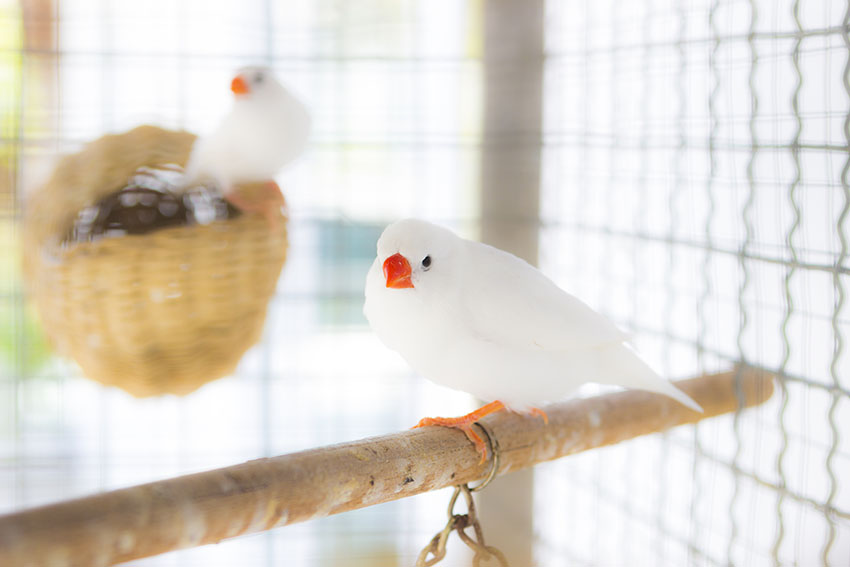
White Zebra finches
Yellow beak
The birds carrying this gene have yellow or light orange beaks instead of the usual red ones. It is found in the gene pool of all types of pet Zebra finch, but is most highly prized in predominantly white birds.
Zebra Finch Hybrids
The Australian and Timor subspecies of the Zebra finch will breed happily in captivity, so breeders don’t usually keep them in the same aviary. They are very occasionally crossed to produce hybrid birds; but the early 20th century fascination with hybridisation has now waned. Hybrids from this type of coupling are fertile; but in exhibition terms they have lost their essential, distinctive characteristics.
Zebras can be cross-bred with their closest finch relatives, such as the Double-barred and Bengalese finch; but, again, this is rarely done now, and you are unlikely to encounter such birds. What it tells us is that various species of Estrildid finch are actually very closely related, a reminder of the almost endless variation and diversity thrown up by evolution.




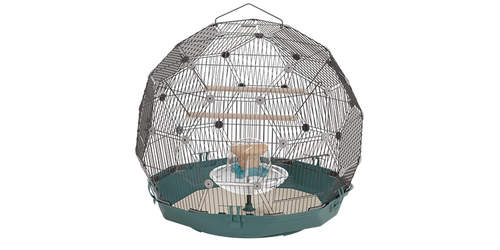
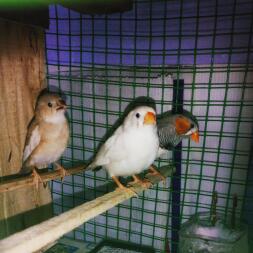
Comments
An Omleteer, 13 December 2024
Hi i have 2 normal male zebra finches and 2 white zebra finches and woundering how to tell the diffrence between male zebra finch and females
Jakobie, 28 December 2022
I have some finches I'm trying to sell, but I'm not sure where to start. Any suggestions are most welcome.
Andrea, 27 June 2022
Hello, Where can I purchase a crested zebra finch?
Deborah, 18 September 2019
I have 6 finches, 2 of them males I was told they are all zebra type, my solid white male and classic orange patch one are best friends I'm wondering why neither male have not tried to mate with the girls.the girls all have that. Crown of feathers in a disarray on top, could my girls be society finches instead of zebras thus causing the males not mating with them? Thanks for your thoughts
Diane, 25 August 2019
I have 2 fawn finches Male and female. One grey female and a black cheeked Male. They all get on in a massive indoor cage. Night time the black cheek Male is really spiteful to the female grey and will not let her in the nest box at night. The grey female has just got its beak turning orange so she is only young. She so much wants to sleep with them all. What do I do